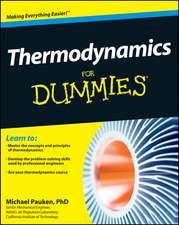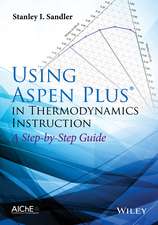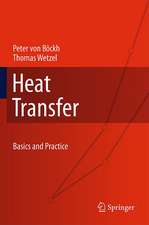Maximum Dissipation Non-Equilibrium Thermodynamics and its Geometric Structure
Autor Henry W. Haslach Jr.en Limba Engleză Paperback – 19 sep 2014
| Toate formatele și edițiile | Preț | Express |
|---|---|---|
| Paperback (1) | 1380.95 lei 6-8 săpt. | |
| Springer – 19 sep 2014 | 1380.95 lei 6-8 săpt. | |
| Hardback (1) | 1386.92 lei 6-8 săpt. | |
| Springer – 25 ian 2011 | 1386.92 lei 6-8 săpt. |
Preț: 1380.95 lei
Preț vechi: 1684.08 lei
-18% Nou
Puncte Express: 2071
Preț estimativ în valută:
264.28€ • 274.89$ • 218.18£
264.28€ • 274.89$ • 218.18£
Carte tipărită la comandă
Livrare economică 14-28 aprilie
Preluare comenzi: 021 569.72.76
Specificații
ISBN-13: 9781489981745
ISBN-10: 1489981748
Pagini: 312
Ilustrații: XIV, 297 p.
Dimensiuni: 155 x 235 x 16 mm
Greutate: 0.44 kg
Ediția:2011
Editura: Springer
Colecția Springer
Locul publicării:New York, NY, United States
ISBN-10: 1489981748
Pagini: 312
Ilustrații: XIV, 297 p.
Dimensiuni: 155 x 235 x 16 mm
Greutate: 0.44 kg
Ediția:2011
Editura: Springer
Colecția Springer
Locul publicării:New York, NY, United States
Public țintă
ResearchCuprins
History of Non-Equilibrium Thermodynamics.- Energy Methods.- Evolution Construction for Homogeneous Thermodynamic Systems.- Viscoelasticity.- Viscoplasticity.- The Thermodynamic Relaxation Modulus as a Multi-scale Bridge from the Atomic Level to the Bulk Material.- Contact Geometric Structure for Non-equilibrium Thermodynamics. Bifurcations in the Generalized Energy Function.- Evolution Construction for Non-homogeneous Thermodynamic Systems.- Electromagnetism and Joule Heating.- Fracture.
Recenzii
From the reviews:
“The author presents his construction of a geometric model for non-equilibrium thermodynamics and his maximum dissipation criterion which is assumed to complement the second law of thermodynamics. … the author explores different concrete situations where his construction of a maximum dissipation criterion may be applied. … This book will be interesting for researchers involved either in applied mathematics or in mechanics.” (Alain Brillard, Zentralblatt MATH, Vol. 1222, 2011)
“The author presents his construction of a geometric model for non-equilibrium thermodynamics and his maximum dissipation criterion which is assumed to complement the second law of thermodynamics. … the author explores different concrete situations where his construction of a maximum dissipation criterion may be applied. … This book will be interesting for researchers involved either in applied mathematics or in mechanics.” (Alain Brillard, Zentralblatt MATH, Vol. 1222, 2011)
Textul de pe ultima copertă
Maximum Dissipation Non-Equilibrium Thermodynamics and its Geometric Structure explores the thermodynamics of non-equilibrium processes in materials. The book develops a general technique to construct nonlinear evolution equations describing non-equilibrium processes, while also developing a geometric context for non-equilibrium thermodynamics. Solid materials are the main focus in this volume, but the construction is shown to also apply to fluids. This volume also:
• Explains the theory behind a thermodynamically-consistent construction of non-linear evolution equations for non-equilibrium processes, based on supplementing the second law with a maximum dissipation criterion
• Provides a geometric setting for non-equilibrium thermodynamics in differential topology and, in particular, contact structures that generalize Gibbs
• Models processes that include thermoviscoelasticity, thermoviscoplasticity, thermoelectricity and dynamic fracture
• Recovers several standard time-dependent constitutive models as maximum dissipation processes
• Produces transport models that predict finite velocity of propagation
• Emphasizes applications to the time-dependent modeling of soft biological tissue
Maximum Dissipation Non-Equilibrium Thermodynamics and its Geometric Structure will be valuable for researchers, engineers and graduate students in non-equilibrium thermodynamics and the mathematical modeling of material behavior.
• Explains the theory behind a thermodynamically-consistent construction of non-linear evolution equations for non-equilibrium processes, based on supplementing the second law with a maximum dissipation criterion
• Provides a geometric setting for non-equilibrium thermodynamics in differential topology and, in particular, contact structures that generalize Gibbs
• Models processes that include thermoviscoelasticity, thermoviscoplasticity, thermoelectricity and dynamic fracture
• Recovers several standard time-dependent constitutive models as maximum dissipation processes
• Produces transport models that predict finite velocity of propagation
• Emphasizes applications to the time-dependent modeling of soft biological tissue
Maximum Dissipation Non-Equilibrium Thermodynamics and its Geometric Structure will be valuable for researchers, engineers and graduate students in non-equilibrium thermodynamics and the mathematical modeling of material behavior.
Caracteristici
Explains the theory behind thermodynamically-consistent construction of non-linear evolution equations for non-equilibrium processes Provides a geometric setting for non-equilibrium thermodynamics through several standard models, which are defined as maximum dissipation processes Emphasizes applications to the time-dependent modeling of soft biological tissue Includes supplementary material: sn.pub/extras












